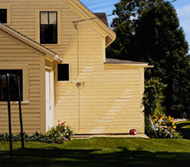Vinyl Siding Cleaning and Maintenance Guide
Vinyl siding is durable, attractive, and easy to maintain. Like any outdoor product, however, even low-maintenance vinyl siding will need attention from time to time. Don't worry! Simply follow the cleaning and maintenance tips in this brochure and your vinyl siding will always look its best.
CLEANING
Washing Vinyl Siding
The best way to wash your vinyl siding is to use a soft cloth or, if an area is hard to reach, an ordinary, long-handled soft-bristled brush. If you have a textured or faux-grain surface on your vinyl siding, keep stains from smearing by cleaning with a soft-bristled or any other gentle cleaning implement. Washing your house can cause stains to loosen, drip, and stain other portions of your siding. To avoid this, start at the bottom of your home and clean upwards. Make sure that you rinse your entire home thoroughly so that cleaning materials do not dry on your siding. Do not let run-off reach any brick parts of your home; cover or block brick facing before you begin cleaning.
Using a Power Washer

Using a power washer is generally acceptable for cleaning your vinyl siding. However, make sure that you are familiar with the washer and have read the instructions thoroughly. Use the washer horizontally only, holding it straight out at eye level. Aimed upwards, power washers can get moisture behind your siding and contribute to rot and decay. Leaks and streaking can also result.
Removing Mold and Mildew
If you have very small areas of mold and mildew, they can easily be cleaned with standard cleansers such as Fantastik® or Windex®. If you need to clean a much larger area and need a larger volume of cleaning solution, try using a mixture of 30% vinegar and 70% water. Other mixtures that can also be successful include 2/3 cup (5 1/3 ounces) powdered household cleaner (e.g., Spic & Span®, Soilax®, or equivalent), 1 quart (32 fluid ounces) liquid laundry bleach, or 1/3 cup (2 2/3 ounces) powdered laundry detergent (e.g., Tide®, Fab®, or equivalent), each mixed with 1 gallon (128 fluid ounces) of water.
Other Types of Stains
One of the most important things to remember when using a new cleaner on your home is to test it on a small area before using it over a large area. A list of cleaners and the stains they have been known to clean respectively is provided below. Once you have completely cleaned a stain, thoroughly rinse the area with water to prevent a cleanser from drying on your house and staining it once more. Organic solvents, which can damage the surface of your siding, should never be used. They are found in products such as undiluted chlorine bleach, nail polish remover, furniture polish/cleaners, and liquid grease remover.
Vinyl Siding Cleaners
General cleaners (e.g., Simple Green®, Nice & Easy®, Armor All®, etc.) can be used to clean spider webs, dirt, and bird droppings. Cleansers that remove specific stains are listed below. Make sure that all cleaners are rinsed before they are allowed to dry.
STAIN |
CLEANERS |
| Bubble Gum | Fantastik®, Murphy Oil Soap®, solution of vinegar (30%), water (70%) and Windex® |
| Crayon | Lestoil® |
| DAP (oil-based caulk) | Fantastik® |
| Felt-tip Pen | Fantastik®, water-based cleaners |
| Grass | Fantastik®, Lysol®, Murphy Oil Soap®, Windex® |
| Lithium (car) Grease | Fantastik®, Lestoil®, Murphy Oil Soap®, Windex® |
| Motor Oil | Fantastik®, Lysol®, Murphy Oil Soap®, Windex® |
| Paint | Brillo® Pad, Soft Scrub® |
| Pencil | Soft Scrub® |
| Rust | Fantastik®, Murphy Oil Soap®, Windex® |
| Tar | Soft Scrub® |
| Top Soil | Fantastik®, Lestoil®, Murphy Oil Soap® |
*SPI nor VSI do not endorse products or processes and makes no warranties for the products referenced herein. Reference to proprietary names is for illustrative purposes only and is not intended to imply that there are not equally effective alternatives.
MAINTENANCE
Discoloration
Consult the labels of any product used in your yard or near your home such as insecticides or herbicides to be sure that they will not stain your siding. If you are applying wet concrete to part of your home, sealants to your deck or other wood fixtures, or any type of stain, cover your siding to prevent significant discoloration.
Heat
High enough temperatures do have the potential to melt or burn vinyl siding, as it is made from organic materials. Make sure that any fire sources, such as outdoor candles and barbeque grills are kept as far away from your vinyl siding as possible. Also remove highly combustible materials like trash, mulch, kindling and dry leaves away from your siding.
Reflected Light
At 160 to 165 degrees Fahrenheit lies the typical heat distortion temperature of vinyl siding. This means that when temperatures exceed this level, warping of your siding can occur. Temperatures such as these can occur when the climate is warm and direct sunlight is reflected from radiated heat sources such as windows, pavement, roofing certain underlayments. To counteract this effect, install screens or awnings and plant shrubbery or other bushes to block reflections.
Damage to Panels
It is not difficult to replace a vinyl panel that has been warped, damaged or stained. While you may wish to contact a siding professional for this step, you can potentially perform the repair yourself. Using an unlocking tool (procured from a siding professional or at a hardware store), unzip the panel above the damaged panel from behind the bottom of the top panel. From this point, you should be able to gently bend the undamaged panel and remove the nails from the damaged panel. You can then nail in a new panel and use the unlocking tool to zip the panels back together.
Painting
You generally will not need to paint your vinyl siding, unless you are looking for a change in the color of your house and do not want to install new siding. Check with the supplier or manufacturer of your siding. Painting vinyl does not necessarily look attractive, and warranties can often be voided by painting.
How can I find out more information?
We can help provide you with our quick and easy Siding Quote form so you can get the pricing information you need for your siding project. And as a thank you will receive the our Insider's Guide to Siding

